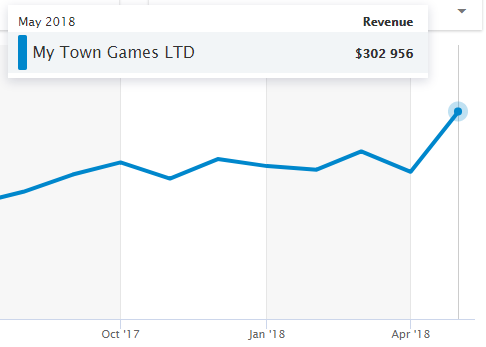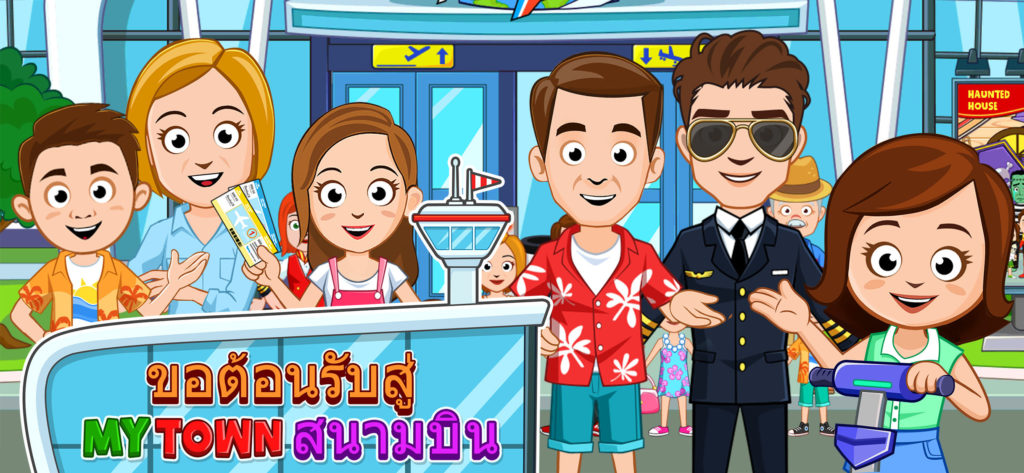How did My Town Games learn to make money from children's games?
Israeli My Town Games specializes in creating premium games for children. Her approach to game design and mutual integration of products allow her to successfully exist on the market and release a title per month.
Children’s games are a difficult segment to earn
The direction of children’s games on mobile platforms is one of the most ungrateful. Children’s games require more attention and diligence in development compared to applications for an adult audience, but from a financial point of view they cannot scale as efficiently.
However, the Israeli team My Town Games, which specializes in paid games for children, has managed to steadily increase revenue since its foundation in 2015. According to DataMagic, she started in July 2015 with a monthly salary of $19, and now she consistently receives more than $200 thousand every month.

Dynamics of sales of My Town Games in recent months (DataMagic)The mechanics of My Town Games projects work with a child’s imagination
At the first acquaintance with the projects, it seems that the games are devoid of gameplay. All right. The company’s projects offer exclusively a set of interactive locations where the player can arrange characters. But that’s the point.
From the very first project, the authors wanted to implement the concept of a doll game within the framework of a mobile application, when a child, through interaction with objects, comes up with a story and mechanics himself. The idea of such a game arose from the founders while watching their daughters.
“When we analyzed the key mechanics that attracted our children to playing with dolls and dollhouses, we noticed that the main gameplay takes place where no one can see it — in their heads. Dolls and other elements that the children played with were just a projection of a much larger story that took place in their imagination,” he said in an interview with App2Top.ru studio CEO Mark Tulchinsky (Mark Tulchinski).

Mark Tulchinsky
This was the starting point for launching a series of projects that are still active.
In May, My Town released its thirty-fifth project, each of which exploits a simple idea.
“Like a regular dollhouse or a doll play session, our projects give the user a set of characters, locations, rooms and accessories to play with within the imagination. Since our home is digital, most of the things that the user sees can be interacted with in some way, even moved. In pursuit of the versatility of our game characters, we added emotions so that the child could change the facial expressions of the characters. In fact, we have improved the experience and the number of options that a child could count on when playing with dolls,” Mark stressed.
From his point of view, it is impossible to compare our usual adult approach to games with applications for children. An adult is looking for something completely different in entertainment today. For the child, the process itself comes first.
“Children are completely different. Look at the classic games that children like to spend time with: drawing, construction, imaginary games. Children’s entertainment has no beginning or end, there is no goal, apart from the game itself that is currently taking place. Drawing won’t reward you with gold coins and you won’t get a new level when playing Lego,” Mark notes.
As for adults, they often play for the sake of victory, progress, plot. Most adult projects are focused on specific goals and objectives. This applies both to projects for large platforms and mobile games, which often keep players with regular rewards.

My Town : Home Doll HouseMutual integration of projects is the key to retaining and monetizing the entire series
But the success of MyTown projects is based not only on the fact that it gave children the opportunity to interact with digital interactive spaces. An important additional feature of the projects is their mutual integration. This creates a common ecosystem that not only increases the retention of all projects in the line, but also regularly stimulates sales.
“Our games are connected to each other, users can move from one title to another along with their belongings and characters, all games are always relevant. So if today a child wants to play a game in which his character breaks his arm at home, then ends up in the hospital, after which he returns to school with a bandaged hand, he will be able to do it. And it will affect three games,” says Mark.
At the same time, all My Town Games titles remain independent. This approach has become an alternative for the company to IAP monetization or advertising, which its founders do not consider acceptable.
“The main problem with IAP is that you give your child a broken game that can only be fully played if parents buy IAP. This is a bad experience for both children and their parents. In the case of a paid game, you know that your child will have everything for a full—fledged game and he will not be bombarded with advertising or persuaded to commit IAP,” says Mark.

My Town : Hospital
On the other hand, there remains the problem of attracting an audience.
Buying users for a paid game without microtransactions cannot be profitable. According to Tulchinsky, his company has no problems with this. MyTown Games attracts new users through cross-marketing.
So that children and parents do not forget about the series of games, the company releases a project per month. From July 2015 to May 2018, the studio released 35 projects. Since it takes from 5 to 7 months to develop each title, a team of 60 people has to work on several games at the same time.
At the same time, the studio tries to make each new game even better: “We have a rule: every next game is better than the previous one. With each new game we increase their size, the number of locations, add characters, mini-games.”
Despite the release of similar projects, they may differ markedly from each other in terms of business metrics. Everything is explained by the fact that projects within the ecosystem differ in roles.
“There are differences between games in terms of the number and length of sessions. This is primarily influenced by the theme of the game. For example, in games like My Town: Stores, there are short daily sessions, as the child comes to the store to buy something, and then returns to his main game. My Town Airport has a much longer session, but it is visited much less often per month, since the child may lose interest in the main gameplay in this area,” explains Mark.

My Town : AirportThe transition to a new setting does not change the approach to design for the company
In recent months, the company, in addition to the urban realistic series My Town, has been actively developing the My Little Princess franchise, which is excellent in setting.
Tulchinsky assures that the introduction of a fairy-tale world, a universe for a little princess, the company was asked for a very long time by the audience.
Despite the change in the world, the mechanics itself remained the same. These are still interactive locations without gameplay as such.
When asked if Mark and his team are tired of creating such games, he replies that this is not even in their thoughts. On the contrary, they want to be the largest players in the market within their niche, and their main goal is to offer children the best dollhouse in the world.
